

 JOHN CHANDLER looks into why there are so many trains through the Level Crossing by Gaugemaster HQ.
JOHN CHANDLER looks into why there are so many trains through the Level Crossing by Gaugemaster HQ.
Road and Rail have to co-exist to form some semblance of a transport infrastructure, however, at times, there may be conflict between the two which often induces an almost resentful attitude of the user of one against the other. Here at Gaugemaster HQ, I can think of no better example than Ford Level Crossing, located just outside our front door. Even my colleagues frequently express disgust and anger that it is closed more than it is open to road traffic. This may come as a surprise, but not all of my 30+ colleagues like, or ‘appreciate’ railways! It is reckoned that the Level Crossing is closed to road traffic for 40 minutes per hour. This was also confirmed when Yapton crossing was being considered for full, instead of half, barriers and Network Rail installed a monitoring system there. The crossing has now been upgraded to full barrier.
So, let’s take a look at the local railway operation which has caused such an effect on the road traffic. Ford station is located between Barnham, Littlehampton, Angmering and Arundel on the Southern Railways operation. This operation covers trains from Southampton, Portsmouth, Bognor Regis and Bath/Bristol to Littlehampton, Brighton, London Victoria and London Bridge. In general, the British rail traveller is adverse to changing trains and prefers the point-to-point service which demands that trains must pass between these eight termini.
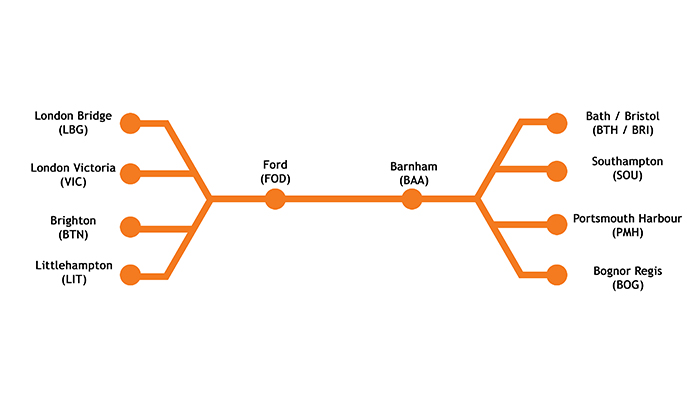
Given Farlington Junction, Barnham Junction, the Ford-Arundel-Littlehampton Triangle and the Arundel Junction, this means that all trains must share the track between Barnham and Ford, including the Level Crossing.
For signals controlling the network, the usual sequence is Red, Yellow, (Double Yellow), Green. Interestingly, a Red Signal is described as ‘ON’, i.e. applied to stop the traffic. All other signal aspects are described as being ‘OFF’. This gives the driver a clue as to what is ahead and can adjust the train speed accordingly, and be prepared to stop at the next signal if necessary. In an ideal world, it is Green, Green, Green. To understand how this works, we need to consider where the signals are placed and the schedule, style (stopper; stops at some stations; direct non-stop) and provenance of the trains passing through; trains to and from London generally take precedence over those to and from Brighton which, in turn, beats Littlehampton (sounds like a good game of Top Trumps in the making! -Ed).
The schematic above shows the track diagram for the local area; signal numbers are also indicated.
The main area is controlled from Arundel (AR) Signal Box with the Boxes at Barnham (BH), Littlehampton (LH) and Lancing (LG) feeding trains into the Arundel Signalling District. Ford Level Crossing is entirely under the control of Arundel Signal Box and is manually operated by the Signaller.
These photos are part of the panel in the Arundel Signal Box:
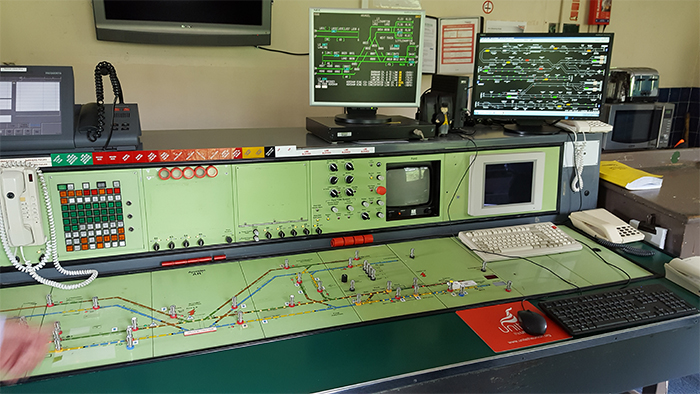
The above image shows an overall view of the Level Crossing end of the panel and includes the Triangle Junction. On the back panel, the leftmost screen provides a view of the Level Crossing itself. The bank of buttons to the left of the screen are the crossing controls.
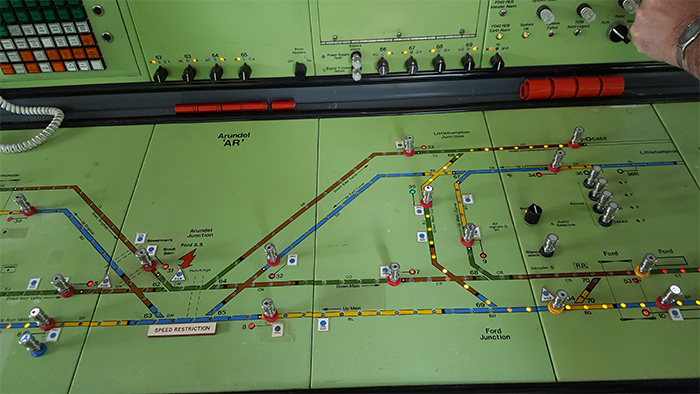
This photo gives a closer view of the panel and allows us to see that signals AR7, AR9 and AR10 are the ones that ultimately protect the Level Crossing.
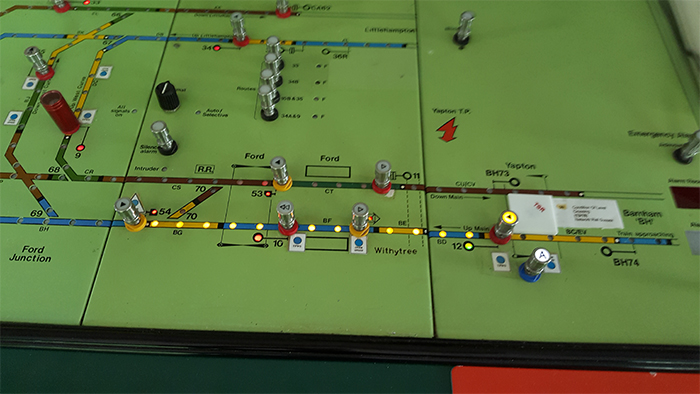
The third photo puts Yapton Level Crossing into context. The first signal, AR12, being on the Ford side of the crossing.
AR7, located 31.26 chains from the Level Crossing, and AR9, 30.42 chains, also protect Ford Junction which forms part of the triangle of junctions. At 80 chains to the mile, these signals are nearly half a mile away from the Level Crossing. There is also a 40mph speed restriction from these signals to the station due to the bridge across the River Arun. AR10, within the confines of Ford Station, is less than 2 chains from the Crossing. The Level Crossing must be fully closed to road traffic before any of these signals can be 'Pulled OFF' and set to either Yellow or Green, to allow the train to pass them. There is then a short delay whilst the driver sets the train in motion. This means if the train has been held at either AR7 or AR9, it will probably be about 2 minutes after the Level Crossing has closed to road traffic before it arrives at Platform 2.
In the photographs above, the silver buttons with the red bases mounted on the track diagram are the Route Setting Buttons; the Signaller presses the button at the start of the route to be set, followed by the button at the end of the route. The electronics behind the panel then check for any conflicts and set the points and signals accordingly to set the route as far as possible. For trains routed across the Level Crossing, signals AR7, AR9 and AR10 remain ON until the Level Crossing has been confirmed as closed to road traffic. The route is then completed and AR7, AR9, or AR10 is 'Pulled OFF' accordingly. Note that, in the second photo above, a route is set from signal AR12 fully through to the transfer to Littlehampton Box and that AR10 is showing as ON (Red) which suggests that the Level Crossing is still open to road traffic.
A further complication arises in that routes can be set in both directions! It has been known for some 5 trains to cross the Level Crossing without the barriers opening to road traffic. From AR7 and AR9, and with an appropriate route set, as soon as a train passes BH73, setting it ON, AR7 or AR9 can be 'Pulled OFF' to allow the next train into the section. In the opposite direction, AR10 can be 'Pulled OFF' by either AR8 or AR35 being set ON.
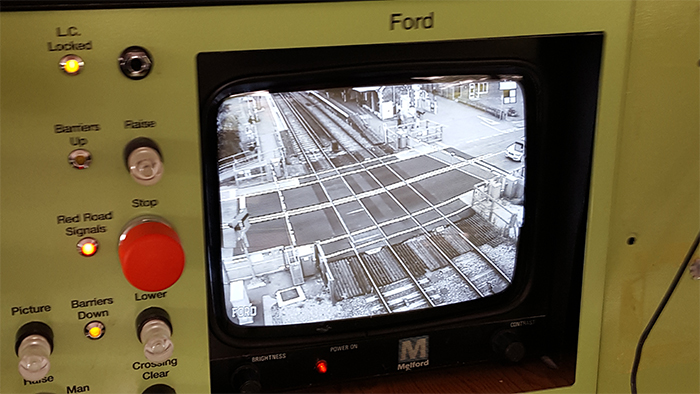
Here we see a close up of the Level Crossing controls and, top right on the screen, the public entrance to GMHQ. This view shows the entire crossing.
This article has been based on the regular non-peak passenger services through the crossing, which equates to some 17 trains per hour. From time-to-time, various Engineering trains including inspection and Rail Head Treatment Trains as well as Specials such as the Belmond Pullman pass through, further infuriating the impatient motorist awaiting the opening of the barriers. Of course any incident or issue on the line can also impact the operational timetables, and again increase the wait times too.
Hopefully this goes some way in showing you the 'inner workings' of the railways and gives you something to think about while waiting for those pesky barriers to rise.
As often in the preparation of articles for Right Lines, I am indebted to several colleagues, friends and ‘insiders’ for their help and advice.